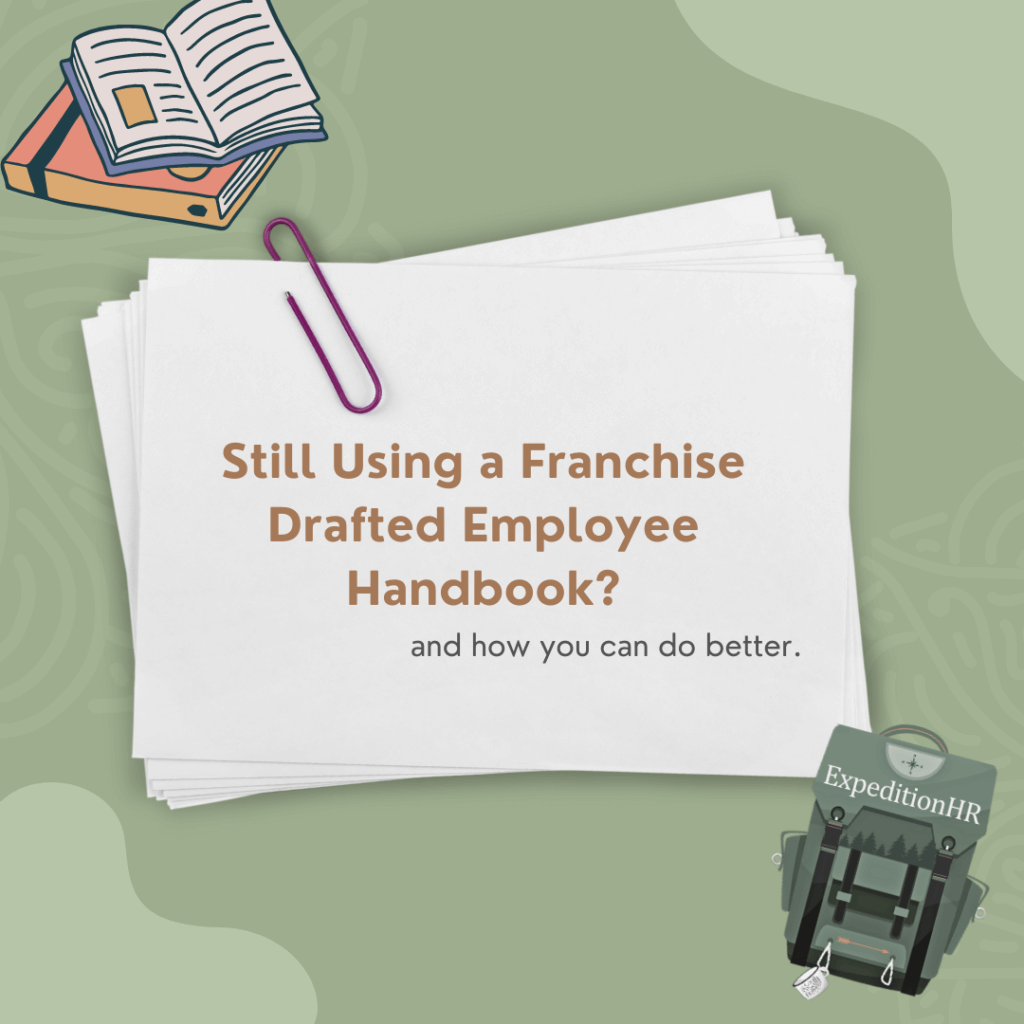Authored By: Amanda Kevin, Founder of ExpeditionHR
When your business begins under the umbrella of a larger corporation, they likely equipped you with an Employee Handbook to help get you off the ground as you build your team and business. While this edition can be a saving grace in the mix of the chaos that is swirling around you at the beginning of building your business, there’s many reasons why you should revisit this document. This same principle should be considered when you utilize a generic Employee Handbook template found online. You should also be cautious as some of these templates can be out of date, placing your business at risk of being out of state and federal compliance.
Here’s some of the problems you might run into:
Big business jargon for your small business.
Oftentimes these handbooks are created with the enterprise in mind, not taking into consideration how each franchisee or owner might run their individual business. A handbook can feel very disconnected from the business when it uses vague high-level jargon, versus specific and relevant information. This can create serious problems and confusion for employees that experience the small business ownership day-to-day, but then when needing to lean on policy, find conflicting information and an unfamiliar overall feel.
The Solution: Use the handbook template given to you as a guide to creating your own. Make sure it rings true to the procedures, technology and tools that your team actually uses. After completing your handbook, you should walk away feeling confident that the information within is true to how you operate your small business.
Corporate jargon instead of your business’ common language.
Think back to the last time you built an Ikea-like furniture set. You opened up all the different packets of hardware and wooden dowels to make sure you had all the pieces you needed. Then off to the instructions you went, step by step to build your new piece. As you went along, you find yourself needing a screw size “A-02”, only to find no “A-02” packet in sight. When this happens what do a lot of us do? We improvise! Using the next closest size screw because they always package these with extra parts – right? Imagine this scenario through the lens of one of your employees in search of a policy on how to go about a cultural norm. If unclear, employees may be left to their own accord to figure out how they want to approach the situation, versus how you’d like them to, creating misalignment within your culture.
The Solution: Your Employee Handbook should feel and read true to your company culture. Meaning that if you use the term “Core Office Hours” when chatting with employees in-person, your handbook should reflect the same language. This builds consistency and comfortability for your employees so that they can feel reassured through policy, and in turn, you can hold them accountable.
State / Multi-state compliance concerns.
If your Employee Handbook was drafted in a state outside of your entity’s state of operation, you may be missing important policies that are essential, better yet, mandatory, for your employees. In addition, if the umbrella company is multi-state, you may have unnecessary policy and addendums in your handbook making it long and burdensome for your employees to navigate.
The Solution: Ensure you understand what state your handbook was drafted for, and if additional states need to be included, partner with an attorney or HR Consultant to make sure you have the appropriate addendums in place to be operating and employing in your particular state.
It may have you signing up for unnecessary policies.
I’ve found that generic handbooks will often incorporate compliance laws, that depending on your size, you may or may not be required to adhere to. A great example of this that I’ve seen time and time again, is the policy for Family and Medical Leave Act (FMLA). Employers under 50 employees are not required by law to offer this policy. While that doesn’t mean you can’t offer some type of policy in lieu of this program, you aren’t held to the federal regulations of the act. If these types of policies are included in your Employee Handbook, you will be held liable to comply with what’s been shared.
The Solution: Have an attorney or HR consultant review your handbook draft. They will be able to assure you which policies are relevant to your business, and which you’re best to leave out. This may seem like an unnecessary step, but the handbook is the foundation of your employee / employer relationship. Of which, employees can hold their employers accountable, and vice versa. So don’t put yourself in a position of taking on undue risk when it isn’t necessary.
Employee Handbooks don’t always receive the attention that other initiatives like engagement performance do, but it’s certainly no less important. In fact, I find the Employee Handbook to be a very important step in setting your employees, and your business, up for a successful exchange.
If you’re unsure if your Employee Handbook is compliant, includes what you are legally required to include, feels bleh or inconsistent with your company culture, please reach out so that we can breathe new life into this document that is the foundation of your employment policies.
—
 Amanda Kevin is the Founder of ExpeditionHR. Leveraging her 10+ years of experience building HR functions for several high growth startups, her passion is in creating a fulfilling and meaningful employee experience. Through alleviating compliance stressors, creating policy that upholds workplace culture, and creating a work environment that professionals will be drawn to, ExpeditionHR will guide small business owners towards fulfilling their wildest dreams.
Amanda Kevin is the Founder of ExpeditionHR. Leveraging her 10+ years of experience building HR functions for several high growth startups, her passion is in creating a fulfilling and meaningful employee experience. Through alleviating compliance stressors, creating policy that upholds workplace culture, and creating a work environment that professionals will be drawn to, ExpeditionHR will guide small business owners towards fulfilling their wildest dreams.

